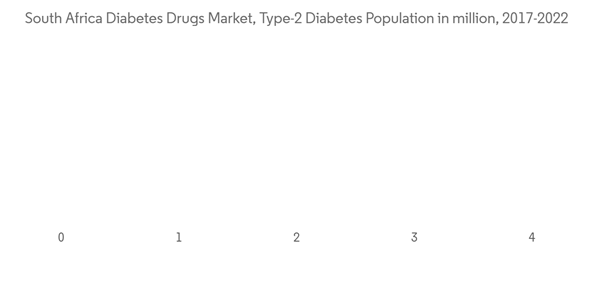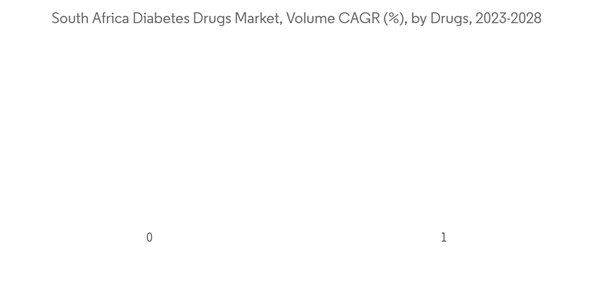The market is estimated to reach a value of more than USD 380 million by 2027.
The COVID-19 pandemic positively impacted the Diabetes Drugs market growth in South Africa. Patients with diabetes, infected with COVID-19 may experience elevated blood glucose, abnormal glucose variability, and diabetic complications. The prevalence of diabetes in people with COVID-19 caused a significant increase in severity and mortality of COVID-19 in people with either type 1 (T1DM) or type 2 diabetes mellitus (T2DM), especially in association with poor glycemic control. While new-onset hyperglycemia and new-onset diabetes (both T1DM and T2DM) have been increasingly recognized in the context of COVID-19 and have been associated with worse outcomes. To avoid aggravation, a patient's blood glucose should be monitored and managed regularly.
Diabetic drugs are medicines developed to stabilize and control blood glucose levels amongst people with diabetes. Diabetic drugs are commonly used to manage diabetes. Diabetic drugs have been potential candidates for treating diabetic patients affected by SARS-CoV-2 infection during the COVID-19 pandemic.
According to IDF Diabetes Atlas 2021, one in nine adults in South Africa are living with diabetes. 73 million adults (20-79) are living with diabetes in the IDF MENA Region in 2021. This figure is estimated to increase to 95 million by 2030. Diabetes is associated with many health complications. Patients with diabetes require many corrections throughout the day to maintain nominal blood glucose levels, such as administering additional insulin or ingesting additional carbohydrates by monitoring their blood glucose levels. Diabetes poses an emerging healthcare burden across the country and is one of the leading causes of premature death, morbidity, and loss of economic growth.
Therefore, owing to the aforementioned factors the studied market is anticipated to witness growth over the analysis period.
South Africa Diabetes Drugs Market Trends
The oral anti-diabetic drugs segment holds the highest market share in the South Africa Diabetes Drugs Market in the current year
The oral anti-diabetic drugs segment holds the highest market share of about 74.1% in the South Africa Diabetes Drugs Market in the current year.Oral Anti-Diabetic Drugs are available internationally and are recommended for use when escalation of treatment for type 2 diabetes is required along with lifestyle management. Oral agents are typically the first medications used in treating type 2 diabetes due to their wide range of efficacy, safety, and mechanisms of action. Anti-diabetic drugs help diabetes patients control their condition and lower the risk of diabetes complications. People with diabetes may need to take anti-diabetic drugs for their whole lives to control their blood glucose levels and avoid hypoglycemia and hyperglycemia. Oral anti-diabetic agents present the advantages of easier management and lower cost. So they became an attractive alternative to insulin with better acceptance, which enhances adherence to the treatment.
In July 2022, Zydus Lifesciences announced that it had received final approval to market Empagliflozin and Metformin Hydrochloride tablets in multiple strengths. Empagliflozin and Metformin Hydrochloride tablets are used with proper diet and exercise to improve glycemic control in adults with type 2 diabetes mellitus. They are also used to lower the risk of cardiovascular death in patients with type 2 diabetes mellitus and established cardiovascular disease.
Due to the early age and longer diabetes duration, the youth is at risk of developing diabetes at a younger age. It lessens their life quality, shortens life expectancy, and increases healthcare costs to society. One of the most effective ways to decrease the prevalence of diabetes in South Africa is to educate citizens and encourage healthy decision-making. South Africa is currently working towards this goal. One recent preventative measure the South African government took was implementing a sugar tax. By charging more for sugary drinks and foods, the government is fighting obesity and helping citizens make more conscious decisions. South Africa briefly launched a Diabetes Prevention Programme (DPP). The DPP aims to integrate intervention treatments into a culturally relevant context through household questionnaires and group gatherings for at-risk individuals.
Owing to the factors above, the market studied is anticipated to grow over the analysis period.
Glucagon-like Peptide-1 Receptor Agonist Segment is expected to register highest CAGR in the South Africa Diabetes Drugs Market
Glucagon-like Peptide-1 Receptor Agonist Segment is expected to register the highest CAGR of 8.7% in the South Africa Diabetes Drugs Market over the forecast period.Glucagon-like peptide-1 receptor agonists (GLP-1RAs) are a class of medications used for treating type 2 diabetes, and some drugs are also approved for obesity. One of the benefits of this class of drugs over older insulin secretagogues, such as sulfonylureas or meglitinides, is that they include a lower risk of causing hypoglycemia. Besides being important glucose-lowering agents, GLP-1RAs contain significant anti-inflammatory and pulmonary protective effects and benefit gut microbes' composition.
Diabetes South Africa (DSA), the Society for Endocrinology, Metabolism and Diabetes of South Africa (SEMDSA), and Youth with Diabetes (YWD) are the various organizations in South Africa working towards helping diabetes patients. DSA is a nonprofit that centers around mobilizing volunteers to demand better treatment for those with diabetes and focuses on educating citizens and lobbying the government for better facilities and cheaper healthcare. Further, SEMDSA researches the genetic sources and causes of diabetes. This organization also promotes high treatment standards and encourages widespread medicine availability. The organizations are promoting the allocation of an increased budget dedicated to funding all aspects of diabetes care and providing a system for better coordination with the Council of Medical Schemes. It is the organization in charge of reimbursement to limit out-of-pocket payments and prevent increased expenditure for patients.
Diabetes is a significant health problem and one of the great challenges for healthcare systems. The disease's growing incidence, prevalence, and progressive nature encouraged the development of new drugs to provide additional treatment options for diabetic patients. The roll-out of many new products, increasing international research collaborations in technology advancement, and increasing awareness about diabetes among people are some market opportunities for the players.
South Africa Diabetes Drugs Industry Overview
The South Africa Diabetes Drugs Market is moderately consolidated, with major manufacturers, namely Sanofi, Novo Nordisk, AstraZeneca, and other generic players holding a presence in the region. A major share of the market is held by manufacturers concomitant with strategy-based M&A operations and constantly entering the market to generate new revenue streams and boost existing ones. These measures taken by the market players will ensure a competitive marketplace, forcing companies to experiment with new technologies.Additional Benefits:
- The market estimate (ME) sheet in Excel format
- 3 months of analyst support
This product will be delivered within 2 business days.
Table of Contents
Companies Mentioned (Partial List)
A selection of companies mentioned in this report includes, but is not limited to:
- Novo Nordisk A/S
- Takeda
- Pfizer
- Eli Lilly
- Janssen Pharmaceuticals
- Astellas
- Boehringer Ingelheim
- Merck and Co.
- AstraZeneca
- Bristol Myers Squibb
- Novartis
- Sanofi Aventis










